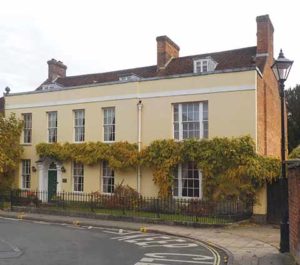Piggy in the middle
Roger Guttridge recalls a libel case that was the talk of Victorian Wimborne
Published in February ’18
When Robert Elcock stepped off the train from Dorchester one Saturday evening in January 1885, he received a hero’s welcome. A carriage and pair waited in Wimborne’s station yard, where the builder, auctioneer and estate agent was met ‘with great cheering by the crowd assembled’. As he took his seat in the carriage, the horses were unharnessed and a team of men began to drag the vehicle through the town. There was a carnival atmosphere as the Town Band led the procession followed by flags and banners and, most significantly, a tableau featuring a huge pig with a net over it. When the carriage reached the Square, Elcock stood and triumphantly addressed the crowd.
It was a remarkable reception of the kind usually reserved for a returning war hero or a sporting champ. Yet Elcock was neither soldier nor sportsman. The unlikely cause of the celebration was the 38-year-old’s triumph in a criminal libel case brought against him by a fellow-Wimburnian. The case had been the talk of Wimborne for weeks but the dispute between Elcock and chemist George Chitty Boor had been building for a couple of years.
Back in April 1883, Boor had published a large poster urging Wimborne’s ratepayers and inhabitants not to be misled by an ‘abusive, scurrilous and insulting Bill’ that falsely accused him of making certain statements at a recent electoral meeting. It named those who ‘intimidated and interrupted’ the meeting and ‘persistently stopped voters from recording their votes’ as George Wilson, Robert Elcock and solicitor H W Dibben.
The issue went unresolved. Almost twenty months later, all Wimborne eyes were focused on a West Street window, where a cartoon had appeared alongside a newspaper cutting that hinted at nepotism. The colour cartoon featured a male pig lying on its back in a steaming tub under the title ‘The Boar in Hot Water’. The window display also included a picture of a chemist’s shop with a sign above the door that read ‘Whines, 1, 2 and 3 Artillery Lane’. This was Boor’s London business address, while Whines was the name of an employee at the Bishopsgate Street chemist’s shop let to his son, Leonard. The newspaper article revealed Leonard Boor as the supplier of disinfectants to the City of London Commission of Sewers, of which his father was not only a member but chairman of its sanitary committee.
Wimborne Magistrates’ Court was the place to be on 28 November 1884. The courtroom was ‘crowded to excess, and the doors had to be closed to prevent the crush from the outside’. People were in ebullient mood, prompting threats of prosecution for contempt of court. Boor’s solicitor claimed the cartoon was calculated to hold his client up to ridicule and contempt; the defending solicitor said Boor must be a ‘very thin-skinned public man’ to take any notice of such a ‘laughable, ridiculous, trumpery thing’. After a twenty-minute retirement, Elcock was committed to the Dorset Assizes charged with malicious libel.
A small army of Wimborne folk headed for the county town on 17 January. ‘Somehow or other,’ reported the Bournemouth Guardian, ‘the idea had got abroad that there would be some fun. From the first it was evident that however funereal the counsel for the prosecution might be in his treatment of the case, human nature would triumph over advocacy and laughter would reign as queen.’
The witness everyone was waiting for was George Wilson, secretary of Wimborne Building Society, which rented the West Street room from Elcock. Wilson’s very arrival in the witness box was a ‘signal for merriment and expectation’ and he did not disappoint. The picture was not a cartoon, he said, but a comic picture, and the copy produced in court was a ‘grossly exaggerated pretence’. Asked about the building society’s connection with the picture, he replied that they did ‘not advance on pigs’. Asked if he knew who put it up, he said he had heard rumours but did not think he could give as evidence ‘all the tittle-tattle of the neighbourhood’.
Judge Pollock called the cartoon a ‘very unneighbourly, ill-advised and ill-conditioned action’. But without evidence that Elcock was personally responsible, Boor’s case collapsed and costs were awarded against him. In his speech in the Square that evening, Elcock thanked the crowd for their reception and remarked that justice had been meted out by a judge before whom he would rather go than before ‘the Great Unpaid’ – a reference to the magistrates who had committed him for trial.
For Boor, 1885 was to prove an eventful year. The Minster parish register records the baptism on 2 February of his son, Cecil, followed on 24 June by the burial of George Chitty Boor himself, aged 54. His wife Alice – twenty years his junior and presumably his second wife, as she would not have been old enough to be Leonard’s mother – continued to live at Percy House until her death in 1899, aged 49.


